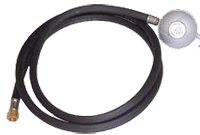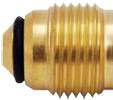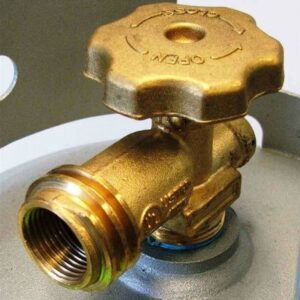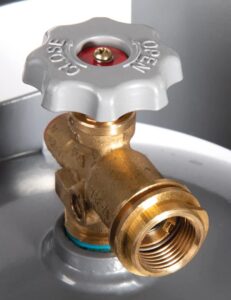This blog was written by Steve Reynolds, who was on the various industry committees that worked on this issue. Steve was a true ‘insider’ relating to the development and launch of the LCC27 gas bottle valve.
LCC27 Gas Bottle Development History – A 4½ Year Journey
Australians have enjoyed outdoor food and barbecues for many decades given the wide-open spaces and good weather, well, mostly!
LPG gas barbecues have played a key role in outdoor cooking, ranging from small camping appliances to full blown backyard kitchens.
They are also incorporated into caravans or mobile homes and even on boats and yachts.
Background History of POL Valves
 In Australia, there are several million barbecues and approximately ten million gas bottles that power these barbecues and related leisure appliances.
In Australia, there are several million barbecues and approximately ten million gas bottles that power these barbecues and related leisure appliances.
Since the 1950’s, many gas bottles in Australia were connected to a barbecue using a “POL” (Prest-O-Lite) gas connection which required a hose assembly (the gas hose plus the gas pressure regulator) to be connected to the gas bottle outlet valve. (see images)
This connection was widely used, particularly in the United States, while other gas connections were used in Europe, Asia and in the United Kingdom.
 The POL valve proved to be a robust process of making a gas-tight connection.
The POL valve proved to be a robust process of making a gas-tight connection.
However, it used a “left-handed” thread and required a spanner, which were both seen as inconvenient by consumers.
A succession of modifications were made, including the use of O-rings on the hose assembly and the provision of a hand wheel for tightening the connection by the consumer.
The original left-handed thread was maintained throughout.
Defining the Problem
In early 2015, a detailed review by the LPG industry association (LPG Australia / Gas Energy Australia) of all safety related incidents involving consumers using LPG bottles identified the POL connection as a significant failure point.
 The POL connection relied on the consumer’s O-ring and connection hardware being in good condition, as well as the consumer using a left-handed thread connection.
The POL connection relied on the consumer’s O-ring and connection hardware being in good condition, as well as the consumer using a left-handed thread connection.
This connection was counter-intuitive to most consumers who see “right-handed” (clockwise to tighten) connections in everyday life, with items like toothpaste tube tops and beverage bottle caps.
The Research Phase
Circa 2015, the LPG industry association commenced a global search for the “best LPG connection” for Australian consumers who use BBQ and leisure appliances.
The detailed search took eighteen months to complete and identified about twelve alternative connection systems for gas bottles currently in use around the world.
Narrowing the List of Options
Based on LPG safety related incident data, input from various state government authorities and various industry groups was obtained.
The list of possible Australian LPG connections was edited and re-edited to reach a very short list of existing connection systems which could replace the long-standing POL connection in Australia.
The design, testing, approval, and manufacturing of a totally new LPG connection for Australia was considered but found not to be viable for a number of reasons.
The best LPG leisure connection already in use in other parts of the world would need to suffice without modification.
The global survey also identified the major issues faced by a country when a commonly used gas connection is changed to a new type.
These issues included consumer acceptance, huge investments in re-tooling and stock write-down costs and uniform acceptance by state authorities and accreditation bodies and standards bodies.
The Challenges
An unavoidable outcome for any change would be a “mish-mash” of two different LPG connections, involving two different LPG bottle valve connections and two different barbecue connections in the same place at the same time.
This situation would persist in the marketplace for some years, during the change-over period, also added to consumer angst – “will this new LPG bottle (valve / connection) fit my new or existing barbecue?”
An outcome of the anxiety was a willingness for some consumers to experiment with “adaptors” which tried to create connections between dissimilar systems.
The results ranged from dissatisfied consumers to injuries and fatalities.
Testing Phase
The “quick connect coupling” called the “QCC” used in LPG leisure bottles in the United States, New Zealand and some Asian countries was initially thought to be both a viable alternative to the POL connection and acceptable in Australia. (see image)
 It was designed to accept both the existing barbecue connection as well as the connection planned for the near future.
It was designed to accept both the existing barbecue connection as well as the connection planned for the near future.
This avoided some of the mish-mash issue and the need to use adaptors.
Samples of the new bottle valve and its connections were tested extensively in Australia by the industry association and its members and deficiencies were discovered.
Using existing barbecues connectors, it was slow to make the connection to the LPG bottle.
Again, with existing LPG bottle filling equipment, the LPG bottle fitted with the new valve was slow to fill.
Thankfully, the valve was an easy right-handed connection and the gas flow stopped if the barbecue was disconnected even if the bottle valve was left open.
Adding an Australian Touch
It was local Australian engineering talent which took the existing QCC model and updated it to obtain an easier connection to the barbecue, faster bottle fill rates and enhanced safety features.
The result was the LCC27 gas bottle valve.
A good outcome for Australian BBQ users, but only when the new gas bottle valve became available.
Coordination of All Involved Parties
Availability relied on tight coordination across industry sectors including the barbecue design and build, the barbecue components industry, the LPG gas bottle and bottle valve suppliers, the re-fillers of LPG gas bottles and the LPG gas bottle retailers.
Of course, state-based gas regulation and the appropriate Australian standards needed to be in place before the first new LPG bottle was sold to the public.
The Changeover of Ten Million BBQ Gas Bottles
The changeover of ten million LPG leisure bottles to LCC27 gas bottle valves needed to be efficient and without consumer angst.
 The introduction of gas bottles with the new LCC27 valve needed to outpace the purchases of new BBQs with the new connectors. (see image)
The introduction of gas bottles with the new LCC27 valve needed to outpace the purchases of new BBQs with the new connectors. (see image)
This was achieved through the introduction of new gas bottles into the population plus the changing of valves when older gas bottles needed their ten-year retest.
The cost of the changeover to new valves was absorbed by the swap industry, and most notably SWAP’n’GO®, who did the lion’s share of the valve changeovers and did not charge extra for exchanging old for new valves.
The fact that the LCC 27 gas bottle is backwards compatible eliminated the need for dangerous adaptors.
In summary, about four and one-half years after the decision to move the Australian LPG leisure bottle valve from the exiting POL to the new LCC27 gas bottle valve.
The first LCC 27 gas bottles were supplied to the marketplace with a target of about eight years for the complete changeover.
- Butane – Butane Gas – Butane Chemical Formula- Butane Gas Canister - April 23, 2025
- BBQ – Gas and Charcoal BBQ Features – Charcoal BBQ vs Gas BBQ Comparison - March 31, 2025
- GPL Gas (GPL Fuel) – GLP Gas – LPG Gasul: GLP – GPL Station Near Me - March 26, 2025
Steve Reynolds
Technical Consultant
Steve Reynolds is a leading expert in the LPG industry with over 22 years of experience. As part of the national management team at ELGAS, Steve ensures the safe and efficient storage, handling, and transportation of LPG. He serves as the lead investigator for incidents and collaborates with authorities on industry developments.
Steve is a technical advisor to Standards Australia and Gas Energy Australia (GEA), and an active member of the World LPG Association (WLPGA), contributing to global standards and technical reviews. He holds a BSc. (Hons) in Industrial Chemistry from UNSW and has held senior safety and technical roles at ELGAS, making him a trusted authority in LPG safety and standards.
